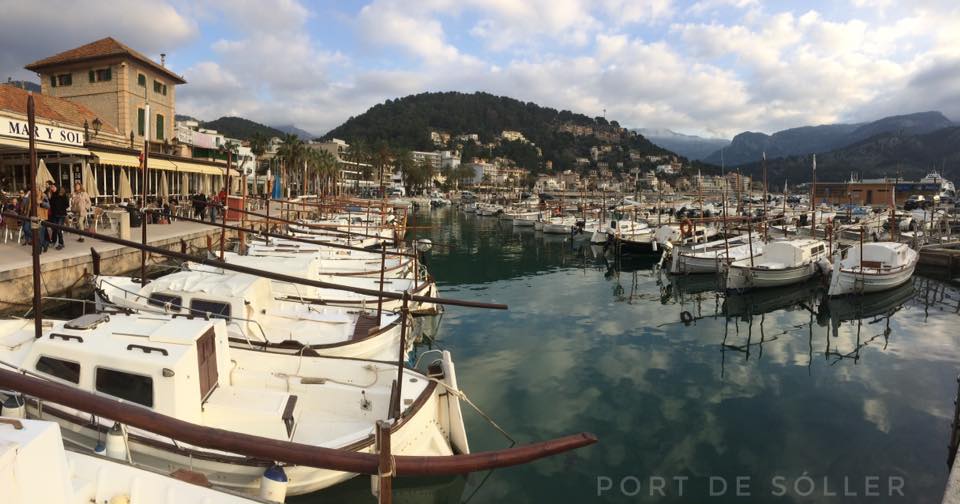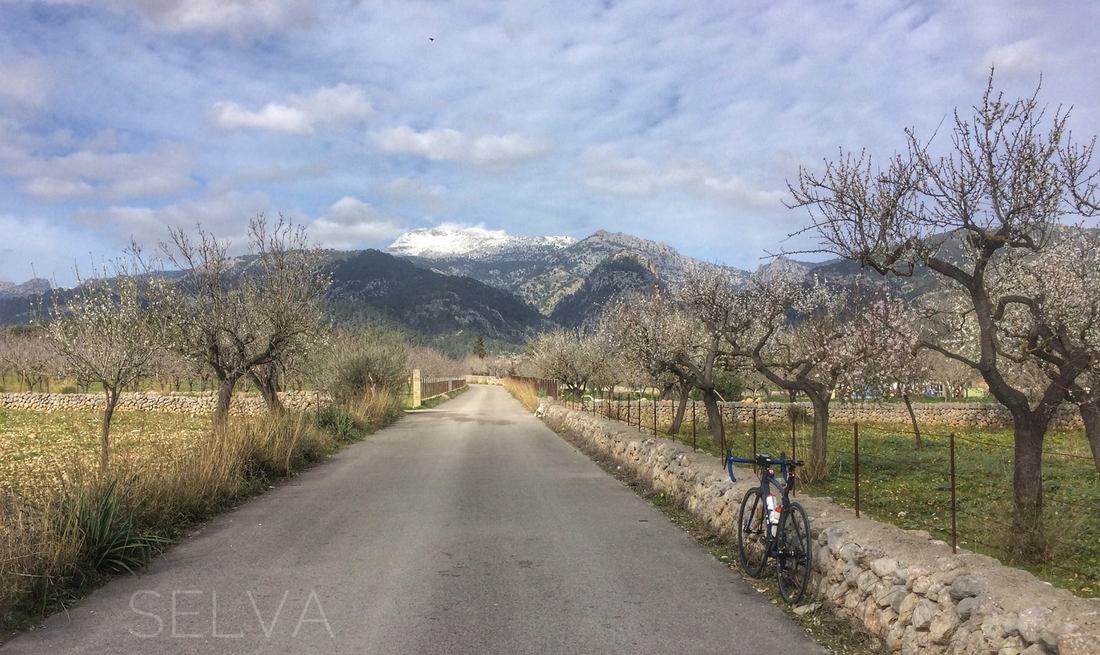|
Below I recall the development of my decision to travel from Hamburg, Germany, my winter residence, to the island of Mallorca, Spain, to initiate training for the 2017 endurance, mountain bike, racing season. This is followed by my thoughts and a few of my experiences on the island over the 26 days that I based my cycling, personal, and business life out of the Village of Santa Margalida in a house built during the lifetime of Galileo Galilee in the 17th-century. In my next blog entry, I'll discuss my experiences from August 2016 to April 2017 self-coaching for the first time since I initiated non-recreational cycling (training and racing) on April 1st, 2013.  From my winter base camp perspective, gazing-out the window from the third floor of an old brownstone on the Bismarckstrassa in Hamburg, Germany, it has been easy for my mind to slip comfortably into day-dreams framed by relatively nearby places where a motivated cyclist could, sensibly, spend part of the winter. I recall being afflicted by these dreamscapes shortly after I arrived to Hamburg for the first time, in September 2015. However, foremost in this evolution of an idea were days spent wandering on my Giant TCR Composite 1.0 road bike through the picturesque countryside of northern Germany. Despite this early contemplation, crystallization and the courage to go where I had not gone myself, despite an obvious and well beaten path pioneered by countless European cyclists, did not make it's debut until part-way through my second and most recent stint in Deutschland. From that point, however, my arrival at a 17th century doorstep in the modest, remote, and generally sleepy, retirement village of Santa Margalida, on the island of Mallorca, Spain, moved along with some haste; and in hindsight I anticipate 'no regrets' forthcoming, only very special memories to celebrate and inspire. After nearly five months residing in a city known to Charlemagne, "King of the Franks from 768, King of the Lombards from 774 and Emperor of the Romans from 800" (Wikipedia), I boarded a local air-carrier on 3 February, 2017; from Hamburg, a few hours later, I landed in Mallorca or Majorca. Spelling preference aside, shortly after arriving I picked-up a scheduled rental car which I rarely used but nevertheless retained for the entire month of February for less than 100 Euro, no doubt one of the benefits of visiting the Mediterranean island, located about 320 kilometers (ca. 200 miles) east of Valencia on the Spanish mainland, during a month when the majority of European cyclists felt the island was too cool and too wet for their pleasure. Regarding those goose bumps and wet fannies, respectively, I'd conclude, in contrast, that I suffered almost not throughout my stay, from cold, or wet, conditions. Much more prominent was the wind, an atmospheric disturbance reliably detected any month of the year on Mallorca. But that too was easily forgotten, on most days, a few notables withstanding, and thus certainly not an omnipresent deductible that had to be factored out of my otherwise unfettered, often gleeful, cycling happiness. Thanks to modern conveniences, namely a cell phone paired with a carrier (O2) providing EU-wide access to the internet with a whopping 7 GB of data for just 40 Euro a month (when I returned to Germany they dropped the monthly rate to just 20 Euro), navigational and other challenges I encountered in Spain were easily overcome in the usual way, tapping and sliding across the various made-for-smart-phone interfaces. Those conveniences allowed me to quickly locate my home for the next month in Santa Margalida which I booked through AirBnB for about 1200 Euro all inclusive (ca. 1350 USD, 25 nights). Here's the link to the property which I would recommend without any hesitation, the property and the managers, including the home owner, were fabulous. Below I've shared a few photos of the property including the view from the 3rd-floor rooftop sitting and dining area. Keep in mind, if you contact Mateu (owner) and Natalie (property manager) about renting this property, that the rate I received was off-season. You may have to pay more per night to rent the Galileo House but the conveniences (location) and experiences (the village and the house) will easily make-up for the cost. The morning following my arrival, 4 February, training officially began for what would be, and only the universe knew then and now, my 2017 season as a amateur, endurance mountain bike, racer and athlete. Armed with a route I'd built using software familiar to me from my European Tour in October 2016, ridewithgps.com, and my Garmin eTrex GPS, I rolled downhill from the Galileo House into wonderland. By the way, I nicknamed the house after Galileo because the structure was built in the 17th century, the century when Galileo published his best known contributions to Science, such as The Assayer (1623). As I rode into the countryside on a typical, mostly sunny, comfortable, no doubt breezy (can't recall) day I mentally pinched myself several times to ensure that I was in fact not daydreaming and still somewhere far to the north in the German countryside. What lay before me was a place with similarities to other places I'd visited but it was still a picture of it's own. Dominated by limestone bedrock that was formed during the Cretaceous when most of central Europe was under a warm, tropical, inland sea, that same limestone remains prominent in all of the architecture noteworthy on the island, including walls, houses, churches, etc. It also dominates the sites between, from stony fields to remnant crags of a foregone continues layer of stone that was once a soft, gooey mud, at the bottom of a nearly forgotten sea (by all but a few geologists and curiosity seekers like myself). The only exceptions to this limestone predominance were formations, granitic and metamorphic types, that I encountered in the Tramuntana Mountains. The Tramuntana present a towering northeast-southwest trending series of summits and valleys that stretch the full length of the island, from Palma to Cap de Formentor. Most of the island is below those mountains and consists of a gently rolling landscape. On the valley floors within and below the mountains, agriculture including potato crops and other vegetables in the lowland valleys and mostly (it seemed) olive production up high are the norm including extensive orchards arranged on ancient terraced slopes. Citrus down low was also common as was much more than I was able to identify whilst whizzing past on my bicycle saddle. Fortunately, each week I visited the local, Santa Margalida, market, a few blocks from the Galileo House, I discovered the full extent of food types that were grown or raised on the island. And for just a few Euro, I struggled to haul all that my eyes desired, it seemed, back to the Galileo House. On my first ride (4 February) I quickly arrived at the village of Muro, about seven kilometers from Santa Margalida. Later on I'd find my way, by chance or planning, to many more of these seemingly ancient towns peppered everywhere on the lowlands, well spaced and defined by agricultural lands. The many images below hopefully capture the feel and the age of these communities. I was often distracted as I rolled through each one, several of them many times over the month I resided on the island, enough so that it was not unusual to miss a turn and then decide to, or not, forge ahead into a new piece of what seemed like my own, private, and splendid cycling infrastructure over the initial 2-3 weeks that I was on the island. After that initial period, it became clear that many more cyclists were arriving each day and by March the island might be accommodating more bikes than cars, something that the locals claimed was true at the peak of the tourist season on the island, a tourist season obviously dominated by cyclists. So-much-so that some hotels on the island hosted not just one, but two fully stocked bike shops! Long ago I discovered that anything is possible in wonderland, nonetheless that little detail, bike shops integrated into hotels, still sends me into the depths of my childhood with all of the naive satisfaction that the description implies. From this point twenty-six days vanished but not without delivering more adventures than any other 26 day period in my life. Whether I was training in the lowlands, below the mountains, or navigating above views of the Mediterranean Sea, partially concealed by peaks rising to as high as 1445 meters (ca. 4740 feet), Puig Major, I was always stitched into a reality that inspired me to consider, almost exclusively, the good parts of life including adventures that I might otherwise have not considered but were now firmly entrenched in my day-to-day dreamscape. Before I reluctantly departed the island, along with my girlfriend, Clarissa Knorr, I exercised my body and my Giant TCR Comp 1 a distance covering 1896 kilometers (1178 miles). My biggest week was 655 kilometers (407 miles); my biggest ride was just over 324 kilometers (201.5 miles) including 4681 meters (15,358 feet) of elevation gain (that was a personal record by the way, distance and climbing). From the perspective of a cyclist opening-up their season of training and racing, Mallorca couldn't be much better, no doubt it is one of the very best options for so-called "spring" training in Europe. Whatever is needed, as far as terrain, flats, short and long climbs, etc, the island delivers in bountiful diversity. And for those travelers that are primarily interested in culture, history, and a slower pace, the island also delivers in copious portions, including tombs that date back to the 7th-century BCE. For sure, anyone that makes their way to this splendid little Spanish island will come away glad that they gave way to the wanderlust inside them. |
�
André BretonAdventure Guide, Mentor, Lifestyle Coach, Consultant, Endurance Athlete Categories
All
Archives
March 2021
|
Quick Links |
© COPYRIGHT 2021. ALL RIGHTS RESERVED.
|





















 RSS Feed
RSS Feed